
The final city we were to visit in Japan would be Tokyo. The train ride from Kyoto to Tokyo is almost four hours, but we had a few excursions planned along the way. After dozens of hours on the internet, Nancy had managed to find the phone number for the Honda Hamamatsu motorcycle factory, and Bryan, with more invaluable help from Keiko, made reservations for a private tour of the plant. Normally only groups of 10 or more people are allowed a private tour but Honda was feeling generous and they granted a private tour to just the two of us!
Hamamatsu is a medium-sized industrial city along Japan's main island's southern coast. The bus from the train station to the plant took about half an hour, and we arrived just a few minutes before our scheduled tour. We expected to find that the plant was a distance from the city itself, but in fact was nestled right in the thick of things on a street which included shops, cafes, and various small businesses.
| This is the entrance to the factory. Because of September 11, they were flying the American flag at the entrance, which seemed like a very nice gesture. |  |
Our tour of the factory was conducted by a very sweet, very apologetic woman from the accounting department whose English was not great. We did manage to communicate our appreciation for the tour that we were provided, and she did understand one or two of the questions that we asked. She carried a card with canned responses to common questions which she diligently, albeit a bit painstakingly, recited when we asked a question whose answer she believed was on the list. We thoroughly enjoyed the tour but unfortunately were not allowed to take any photos inside the factory itself. Needless to say, the motorcycle assembly is performed with the utmost efficiency and attention to quality.
We were allowed to take a photo in the main entrance hall, in front of their display of some representative motorcycles from the Honda line. We're wearing the Honda baseball caps that they gave to us as a souvenir of our tour.
After the tour, we were quite parched so we decided to duck into a restaurant for something to drink. Of course, we don't read Japanese, so when we ducked into this restaurant, we found that it was a Karoke bar of sorts. There were a handful of elderly ladies, all decked out in eveningwear, sipping scotch and singing Karoke. What fun! We had our iced tea and beer and headed out. We got back on the train for another hour or so, and then emerged in Yokahama, where we had plans to visit the ramen museum. The ramen museum is an entire museum dedicated to ramen soup - the instant noodle soup food which includes such brands as cup o' noodle, and the square ramen noodle soup packets that so many of us lived off of during our poor college days.
The museum had alot of interesting exhibits but unfortunately it was about 90% Japanese. A few displays had a short English summary but the vast majority of the text was Japanese-only. This was really too bad as the displays looked very entertaining but we couldn't understand most of them.
| Here's a display of ramen noodle celebrity editions, including the Arnold Schwarzeneggar model in the upper-right-hand corner. "Hasta la ramen, baby!" | 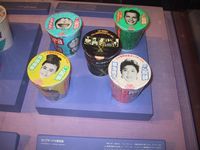 |
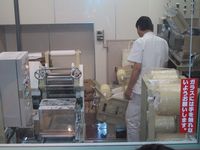 |
The museum makes its own ramen on-site. Visitors can watch the ramen being prepared through a window inside the museum. |
After enjoying the great ramen museum displays on the top floor, we descended down two flights to the basement floors. We thought that the ramen museum was really cool until we made our way downstairs - and then we were simply blown away by how incredibly awesome it was. This place is an absolute must-visit for anyone in the Yokohama area.
The downstairs consists of two floors of alleys decorated to look like a 1950's-era Japanese city, about the time that ramen noodles were first introduced. The attention to detail of the alleys was incredible, and they really did give the feel of being transported back in time. All along the alleys small cafes beckon the visitor in for a bowl of ramen noodle soup. Each cafe has its own special variety of soup and the low cost of the soup - about $4 per bowl - encourages the visitor to try several varieties of the delicious soup.
| This is an example of one of the alleys. |  |
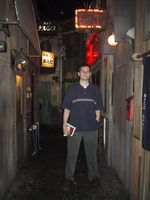 |
Here's Bryan in a 1950's-era Tokyo backalley. |
This photo was taken from the second floor looking out on the central area. The lower floor was the liveliest with live storytelling performances for the kids - which the adults seemed to find just as hilarious as well, although we unfortunately couldn't understand them as they were in Japanese - and lots of cafes packed with people enjoying ramen soup. The ceiling was painted to look like a cloudy night at dusk and the effect really was almost believable.
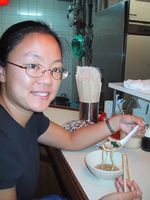 |
Here's Nancy enjoying a bowl of delicious ramen soup. | 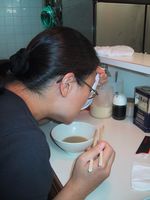 |
After our ramen noodle dinner, we reboarded the train for the final leg of our journey to Tokyo. On our first night in Tokyo we had no hotel reservations and had planned to stay at a capsule hotel. A capsule hotel is a hotel in which the rooms are only just big enough for one person to fit into, and are stacked one on top of the other and side by side. The rooms aren't really so much rooms as they are capsules, hence the name capsule hotel. Only some capsule hotels accept women, most being geared towards the male business traveller on a budget, so our choices were limited. We tried the first capsule hotel on our list which claimed to accept women and found that it did. The cost was per capsule was pretty low - about $40 per night each, which in Japan is incredibly cheap for a hotel room. There were about six floors of men's capsules and one floor of women's. The men's and women's bathrooms were on their own, individual floors as well. We found the capsule hotel to be adequate. You have to crawl into your "room" and then you only have enough room to sit up. The TV had a coin vending machine attached. One problem is that we had unwittingly chosen an older, more low-tech capsule hotel and didn't get to enjoy any of the cool modern features that we had read about being in newer capsule hotels. That being said, our capsules provided us with a fine night's rest and a hot shower the next day for very little money, and we were well satisfied with our choice.
The next day we attended a Kabuki Theatre show featuring traditional Japanese theatre. It was quite different than the Beijing Opera we had seen in China. Men played women's roles and the plot seemed much more involved than the Beijing Operas we had seen. Also the performance was much longer - nearly 2 hours. It was actually quite boring and Bryan had to try very hard to stay awake (it's all in Japanese so there isn't any way to really understand what is going on, and not much seems to happen in any case). We're not sure that we'd recommend this form of entertainment for anyone who doesn't understand Japanese.
Photos were not allowed during the performance but here's a photo of the theatre from the outside.
| Looks like Nancy's found another pig on the streets of Tokyo, this time it's a stuffed one. Note the bag of chestnuts that she also managed to locate. | 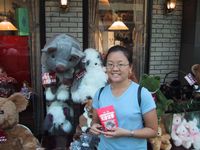 |
After some strolling and shopping, we went to bed early in preparation for an early start the next day. We had plans to go to Onioshidashi, which is about an hour's bullet train ride away from Tokyo. This is an area which experienced a tremendous volcanic eruption in the 1700's which destroyed an entire village and which produced a cloud of ash so large that it was reportedly visible from Europe. The landscape of this area consists of jagged, twisted formations of lava rock that were produced when the lava which flowed from the volcanic eruption cooled on its way down the mountainside.
 |
Here comes the train to take us to Karuizawa and then to catch the bus to Onioshidashi. |
The weather was beautiful - clear, blue skies with fluffy white clouds, and temperatures in the mid 40's.
| Here's the landscape on approach to the park. | 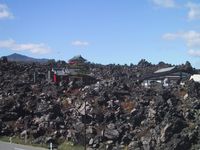 |
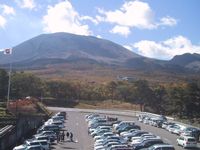 |
This panoramic shows a large section of the park and the mountains beyond.
 |
Here we are among the lava rocks. Oops - the signs said no leaving the paved walkways ... oh well. |  |
Here are some scenes of lava rocks from around the park.
 |
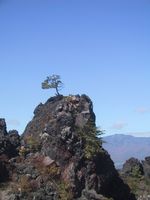 |
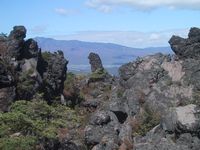 |
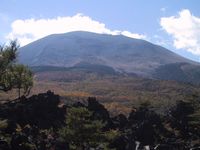 |
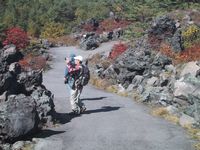 |
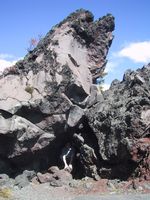 |
Here's another panoramic showing the rocks and the paved pedestrian walkway amongst them.
Another panoramic - it was a great day for panoramic photos!
Some strange power of the volcanic rock had Nancy seeing multiples ... Just think how quickly the dishes would get done with 6 Bryans!
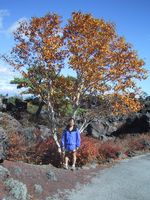 |
Nancy in the park. |  |
Some plants, trees, and flowers managed to take hold among the lava rocks.
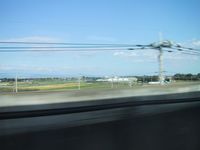 |
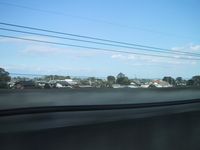 |
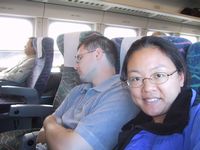 |
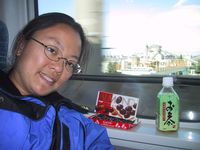 |
Here we are on the bullet train back to Tokyo after a great day at Onioshidashi. Bryan sleeps, Nancy eats.
That evening we visited the famous Unagi (eel) restaurant that Nancy had been dreaming about for the entire trip. It was hard to find but worth the trouble. They make the unagi from a live eel so from order time to eating time lapsed 40 minutes of hunger. But, well worth it!!
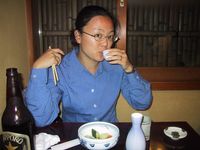 |
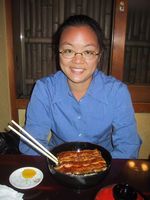 |
Here's Nancy enjoying the meal.
Back to: Japan, October 10 - 12: Himenji and Kyoto